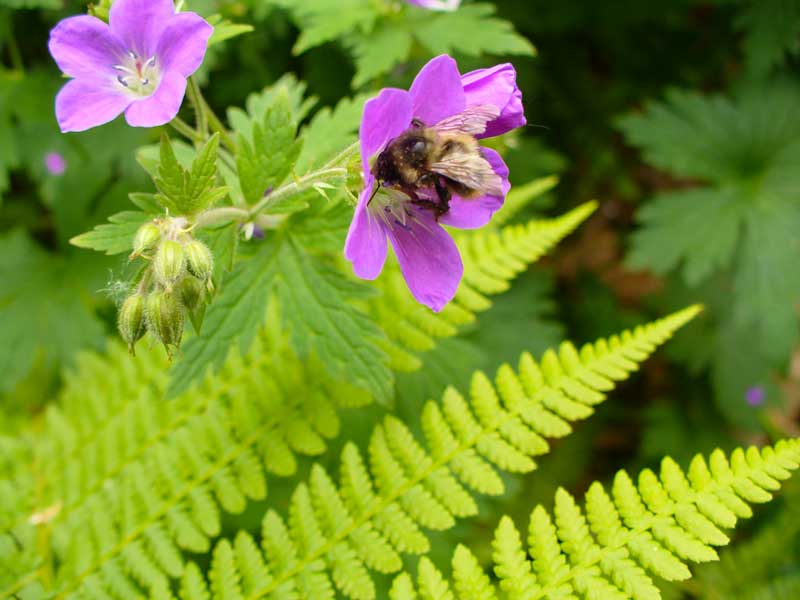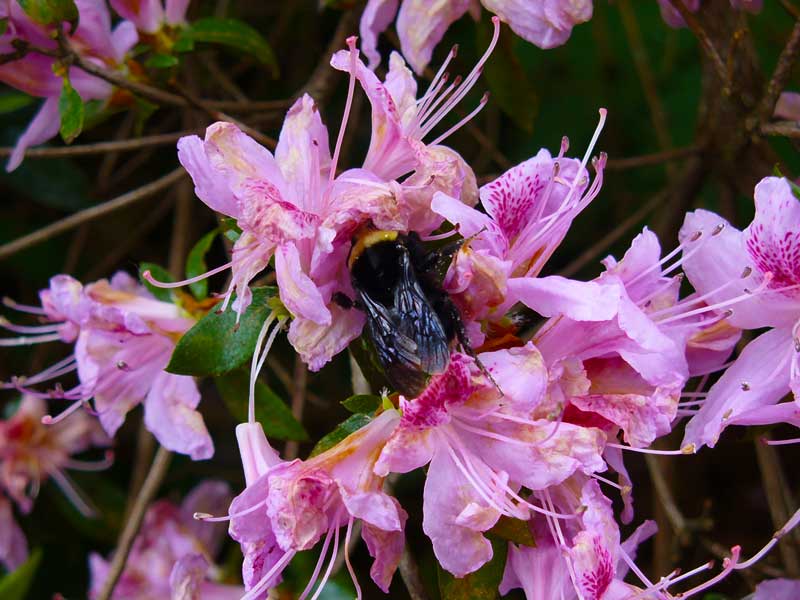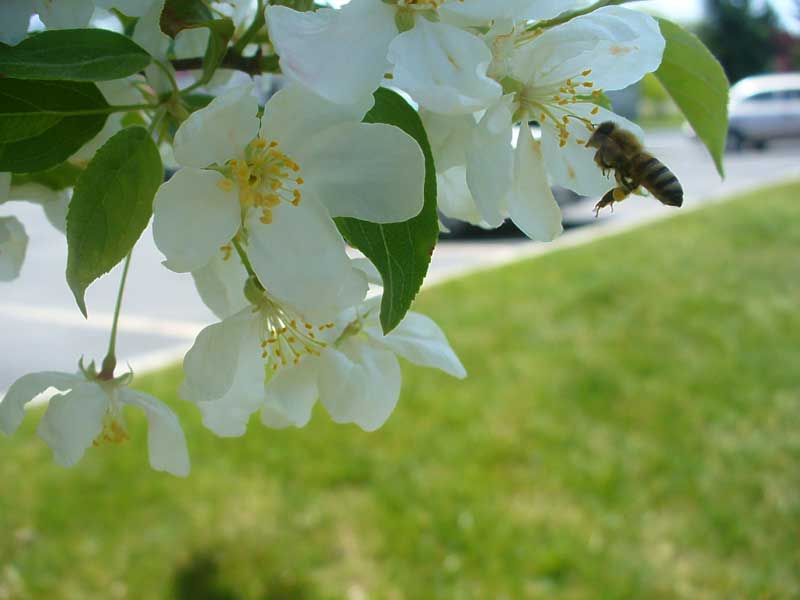Fun bee facts: Read all about bees and find answers to all your bee questions
How many types of bees are there?
When I say bees normally people think of honeybees. However, there are over 25,000 species of bees worldwide. North America has around 4,000 native bees including bumblebees and mason bees. All of these different bees help pollinate flowering plants. Pollination is vital for fruits and seeds to form. Without bees many crops would not develop.
What do bees do?
Picture: A bumblebee pollinates a wild flower.
Honeybees are responsible for at least $10 billion dollars worth of pollination a year. They pollinate between 25-35% of all fruits and vegetables. The rest of the plants, fruits and vegetables are fertilized by native bees and other pollinators such as hover flies. Almost all wild flowers are pollinated by native bees such as bumblebees.
The job of pollinating plants doesn't get danger pay, but there is increasing evidence that it should. Current evidence shows that pesticide exposure is either contributing to or causing colony collapse disorder by impairing bee's memory and ability to learn (Gill et al. 2012, Palmer et al. 2013, Williamson and Wright 2013), reducing bee's winter survival (Lu et all. 2012), keeping bees from getting into the dancing groove (Eiri and Nieh 2012), slowing down bumblebee pollen gathering (Felton et al. 2014), shrinking bee's size (Baron et al. 2014) and making them more likely to get ill from gut pathogens (Pettis et al. 2013). One recent study shows that neonicotinoid insecticides cause epigenetic changes to honeybee larva. The activity of the genes involved in toxin breakdown (p450 enzymes) was increased while energy pathways were downregulated (Derecka et al. 2013).
What bee is best at pollination?
For the lowdown on which bee comes out tops in pollinating see Bumblebee vs Honeybee Smackdown. Other native bees are also effective pollinators and should be encouraged in your yard or garden.
How do you address a bee?
 Picture: A queen bumblebee.
Picture: A queen bumblebee.
Do bees prefer the nomenclature 'honeybee' or 'honey bee'? Most bees (and Google) are pretty laid back and will accept either term. Officially it is honey bee or bumble bee but I tend to use the less formal honeybee or bumblebee
The Queen Bee demands to be called 'Her Royal Highness'. I've used queen bee to refer to any fertile egg laying female bee. Any bee working is normally female, while any bee aimlessly hovering around is normally male. To even things out the females get the stingers.
I find it best to address any non queen bee with a stinger as 'Madam' unless personally invited to be on a first name basis. If you and the bee are really tight, fell free to use terms of endearment like 'honeypie' or 'little yellow hummer' (make sure you are bbf first since bees can be lacking in a sense of humor).
Is there a bee celebration?
National Honey Bee Day is August 16th! The 2014 theme is "Sustainable Gardening Begins with Honey Bees." Want to support Bee Day? See the National Honey Bee Day website to read a bee blog or be a bee supporter. Want to really support National Honey Day? Dress up in a giant bee costume - extra points for doing the waggle dance (if you do send me a photo and I'll put it up on my website)!
What do bees eat?
Almost all bees are vegetarians who eat pollen and/or nectar from flowers. Flowers produce nectar, which is a sweet liquid designed to attract insect pollinators. Other parts of the plant can also produce nectar in extranuptial nectaries (these are normally used in plant defense). Nectar can contain sugars, amino acids, volatile aromas, and other chemicals. Flowers also produce pollen which are male germ cells (gametes). Pollen is a sticky yellow, orange, red or greenish powder which fertilizes the plant's female germ cells to produce a seed.
Honeybees make beebread, honey and royal jelly from nectar and pollen. Bees mix pollen, nectar and a little honey together. This protein rich food is fermented in cells near the brood chamber until it undergoes a chemical change and becomes beebread. Beebread apparently tastes 'doughy' and it is used to feed larva. To make honey, worker bees add an enzyme, invertase, to the nectar (and some pollen) and dehydrate it. Honey is dehydrated to about 18% moisture and then stored in capped honeycombs. This sweet treat is an important food source; especially in the winter months when no flowers are available. A normal hive of bees requires about 100 pounds of honey to survive the winter. Royal jelly is made from chewed pollen mixed with bee enzymes. It is also called 'bee milk' and is given to all larvae for the first 2 days and to queen bees for their whole childhood.
How do bees pollinate?
Picture: Honeybee flies in for a flower landing.
When bees collect pollen and nectar they brush against the flower. Pollen, plant male gametes, also sticks to the bee. When a bee goes to another flower pollen can brush off on the stigma (the female organ). This transfers pollen from one plant to another. Transferring pollen to the flower resulting in pollination or fertilization of the plant.
Why do bees dance?
Honeybees do dances to tell other members of the hive where to find good flowers! The waggle dance, not to be confused with twerking, is a figure eight pattern alternating between left and right turns. The direction and the length of the waggle dance corresponds to the direction and the distance of the food source. Bees let other bees know direction by dancing in a line relative to the position of the sun. The more excited the bee is about their great flower find the more energetically they will wiggle as they waggle (Landgraf et al. 2011). Some scientists consider the waggle dance a language but there is still debate about it (Crist 2004).
Where do bees live?
Some bees like to live by themselves. They are called solitary bees. Often these bees make their own nest but will form a neighborhood of individual 'houses'. Like good neighbors, they may even help each other with nest guarding and foraging duties. Leafcutter, mason and mining bees often form nesting neighborhoods.
Other bees are friendly and prefer to live in a hive. They are known as social bees. Bees may make nests out of mud, leaves, wax or polyester. To see where your favorite bee lives check out common bee types.
Interesting bee facts:
The bee 'stinger' is a modified ovipositor (or egg laying tube) combined with a venom gland. Since only females have ovipositors this means that male bees cannot sting.
It takes 12 worker bees to make 1 teaspoon of honey!
It take 2 million flower visits to make 1 pound of honey. One honey bee visits about 225,000 flowers a day (thus the term 'busy as a bee' is true).
Colony Collapse Disorder (CCD)
Since 2006-2007 honeybee hives in the USA have been suffering from colony collapse disorder (CCD). This means that most of the bees in a hive die and there aren't enough bees to maintain the hive so it 'collapses'. Sometime all the bees die or starve, other times the remaining group of surviving bees take off for greener pastures. Some beekeepers have lost 30-90% of their hives.
The cause of this used to be unknown but in the past few years the finger has been gradually pointed at a combination of factors including pesticides, more specifically the new group of insecticides known as neonicotinoid pesticides. These pesticides were released only a few years before CCD disorder first appeared and there is mounting evidence that they are extremely harmful to bees. While pesticides may not be the only factor contributing to CCD they are certainly either aggravating or precipitating the problem.
Other factors being explored that might contribute to CCD are stressors such as bee parasites, bee diseases, management problems and malnutrition. Some of these are relatively new stressors such as the gut parasite Nosema, varroa mites and the Israeli Acute Paralysis virus.
Why should you care about the bees?
"Not a single bee has ever sent you an invoice. And that is part of the problem - because most of what comes to us from nature is free, because it is not invoiced, because it is not priced, because it is not traded in markets, we tend to ignore it."
By Pavan Sukhdev, United Nations report, The Economics of Ecosystems and Biodiversity.
References:
- Baron GL, Raine NE and Brown MJF. Impact of chronic exposure to a pyrethroid pesticide on bumblebees and interactions with a trypanosome parasite. J. Applied Ecology. 2014 doi: 10.1111/1365-2664.12205 (full text)
- Blacquière T1, Smagghe G, van Gestel CA, Mommaerts V. Neonicotinoids in bees: a review on concentrations, side-effects and risk assessment. Ecotoxicology. 2012;21:973-92. Pubmed. doi: 10.1007/s10646-012-0863-x (full text)
- Crist E. Can an Insect Speak?: The Case of the Honeybee Dance Language. Social Studies of Science, 2004;34: 7-43. doi: 10.1177/0306312704040611 (full text)
- Derecka K, Blythe MJ, Malla S, Genereux DP, Guffanti A, Pavan P, Moles A, Snart C, Ryder T, Ortori CA, Barrett DA, Schuster E, Stöger R. Transient Exposure to Low Levels of Insecticide Affects Metabolic Networks of Honeybee Larvae. PLoS ONE, 2013; 8: e68191 Pubmed. doi: 10.1371/journal.pone.0068191 (full text)
- Eiri DM, Nieh JC. A nicotinic acetylcholine receptor agonist affects honey bee sucrose responsiveness and decreases waggle dancing. Journal of Experimental Biology, 2012; 215: 2022. Pubmed. doi: 10.1242/jeb.068718
- Feltham H, Park K, Goulson D. Field realistic doses of pesticide imidacloprid reduce bumblebee pollen foraging efficiency. Ecotoxicology. 2014 Jan 22. [Epub ahead of print] Pubmed.
- Gill RJ, Ramos-Rodriguez O, Raine NE. Combined pesticide exposure severely affects individual- and colony-level traits in bees. Nature, 2012;491:105-8. Pubmed. doi: 10.1038/nature11585 (full text)
- Landgraf T, Rojas R, Nguyen H, Kriegel F, Stettin K. Analysis of the Waggle Dance Motion of Honeybees for the Design of a Biomimetic Honeybee Robot. PLoS ONE, 2011;6. Pubmed. doi: 10.1371/journal.pone.0021354 (full text)
- Lu C, Warchol KM, Callahan RA. In Situ Replication of Honey Bee Colony Collapse Disorder. Bulletin of Insectology, 2012;65:99-106. Full text.
- Palmer MJ, Moffat C, Saranzewa N, Harvey J, Wright GA, Connolly CN. Cholinergic pesticides cause mushroom body neuronal inactivation in honeybees. Nature Communications, 2013;4:1634. Pubmed. doi: 10.1038/ncomms2648 (full text)
- Pettis JS, Lichtenberg EM, Andree M, Stitzinger J, Rose R, vanEngelsdorp D. Crop Pollination Exposes Honey Bees to Pesticides Which Alters Their Susceptibility to the Gut Pathogen Nosema ceranae. PLoS ONE. 2014:8; e70182. Pubmed. doi: 10.1371/journal.pone.0070182 (full text)
- Williamson SM, Wright GA. Exposure to multiple cholinergic pesticides impairs olfactory learning and memory in honeybees. Journal of Experimental Biology, 2013;216:1799-807. Pubmed. doi: 10.1242/jeb.083931 (full text)
